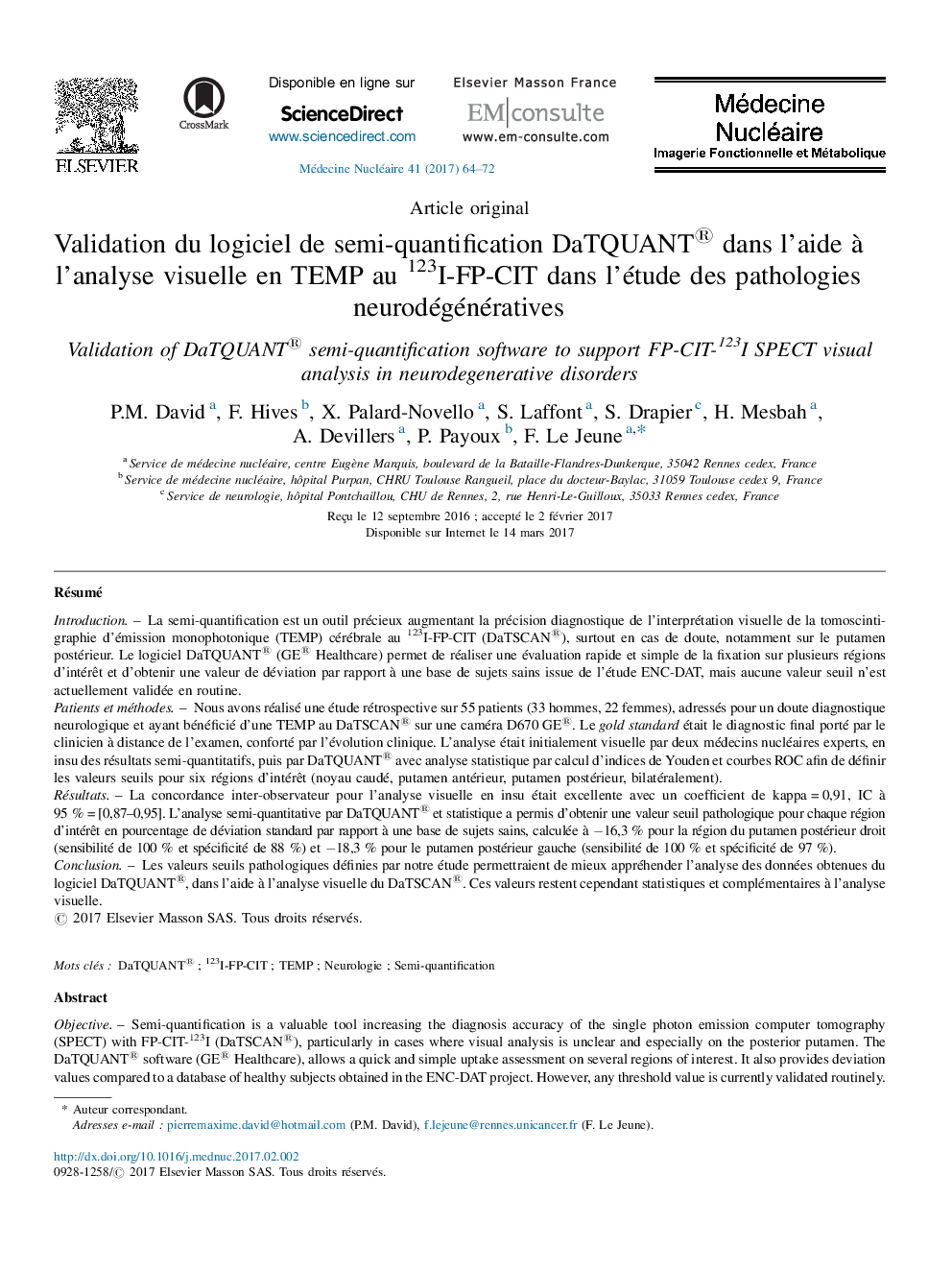| کد مقاله | کد نشریه | سال انتشار | مقاله انگلیسی | نسخه تمام متن |
|---|---|---|---|---|
| 5727871 | 1411622 | 2017 | 9 صفحه PDF | دانلود رایگان |

RésuméIntroductionLa semi-quantification est un outil précieux augmentant la précision diagnostique de l'interprétation visuelle de la tomoscintigraphie d'émission monophotonique (TEMP) cérébrale au 123I-FP-CIT (DaTSCAN®), surtout en cas de doute, notamment sur le putamen postérieur. Le logiciel DaTQUANT® (GE® Healthcare) permet de réaliser une évaluation rapide et simple de la fixation sur plusieurs régions d'intérêt et d'obtenir une valeur de déviation par rapport à une base de sujets sains issue de l'étude ENC-DAT, mais aucune valeur seuil n'est actuellement validée en routine.Patients et méthodesNous avons réalisé une étude rétrospective sur 55 patients (33 hommes, 22 femmes), adressés pour un doute diagnostique neurologique et ayant bénéficié d'une TEMP au DaTSCAN® sur une caméra D670 GE®. Le gold standard était le diagnostic final porté par le clinicien à distance de l'examen, conforté par l'évolution clinique. L'analyse était initialement visuelle par deux médecins nucléaires experts, en insu des résultats semi-quantitatifs, puis par DaTQUANT® avec analyse statistique par calcul d'indices de Youden et courbes ROC afin de définir les valeurs seuils pour six régions d'intérêt (noyau caudé, putamen antérieur, putamen postérieur, bilatéralement).RésultatsLa concordance inter-observateur pour l'analyse visuelle en insu était excellente avec un coefficient de kappa = 0,91, IC à 95 % = [0,87-0,95]. L'analyse semi-quantitative par DaTQUANT® et statistique a permis d'obtenir une valeur seuil pathologique pour chaque région d'intérêt en pourcentage de déviation standard par rapport à une base de sujets sains, calculée à â16,3 % pour la région du putamen postérieur droit (sensibilité de 100 % et spécificité de 88 %) et â18,3 % pour le putamen postérieur gauche (sensibilité de 100 % et spécificité de 97 %).ConclusionLes valeurs seuils pathologiques définies par notre étude permettraient de mieux appréhender l'analyse des données obtenues du logiciel DaTQUANT®, dans l'aide à l'analyse visuelle du DaTSCAN®. Ces valeurs restent cependant statistiques et complémentaires à l'analyse visuelle.
ObjectiveSemi-quantification is a valuable tool increasing the diagnosis accuracy of the single photon emission computer tomography (SPECT) with FP-CIT-123I (DaTSCAN®), particularly in cases where visual analysis is unclear and especially on the posterior putamen. The DaTQUANT® software (GE® Healthcare), allows a quick and simple uptake assessment on several regions of interest. It also provides deviation values compared to a database of healthy subjects obtained in the ENC-DAT project. However, any threshold value is currently validated routinely.Patients and methodsA retrospective study was conducted in 55 patients (33 men, 22 women) referred for a suspicion of neurological disorders and who underwent SPECT imaging with DaTSCAN® on camera D670 GE®. Final diagnosis made by neurologist time after the SPECT was established as a reference, reinforced by clinical evolution. Analysis was initially visual without semi-quantitative results, realized by two experimented nuclear physicians, and then semi-quantitative analysis was made by DaTQUANT® with calculation of Youden indices and ROC curves so as to define threshold values for six regions of interest (caudate, putamen anterior, posterior putamen, bilaterally).ResultsInterobserver match in the blind visual analysis was excellent with kappa coefficient = 0.91, CI at 95% = [0.87-0.95]. The semi-quantitative and statistical analysis by DaTQUANT® determined pathological threshold values for each region of interest, setting a standard deviation percentage from a database of healthy subjects, worth â16.3% for the right posterior putamen (sensitivity of 100% and specificity of 88%) and â18.3% for the left posterior putamen (sensitivity of 100% and specificity of 97%).ConclusionThe pathological threshold values defined by our study would improve the data analysis obtained from DaTQUANT® software and would support the DaTSCAN® visual analysis. Nevertheless, such statistical values are complementary to visual analysis.
Journal: Médecine Nucléaire - Volume 41, Issue 2, MarchâApril 2017, Pages 64-72